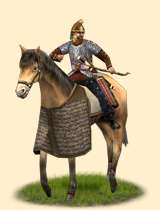Ysaninu Aysna (Early Saka Nobles)
 |
Weapons | Defence | Mental | ||||||
|---|---|---|---|---|---|---|---|---|---|
| Primary | Secondary | Armour: | 10 | Morale: | 15 | ||||
| Type: | none | spear | Shield: | 0 | Discipline: | disciplined | |||
| Attack: | 6 | 4 | Skill: | 11 | Training: | trained | |||
| Charge: | 33 | 33 | Recruitment | Other | |||||
| Lethality: | 1 | 0.33 | Soldiers: | 25 | Hit Points: | 1 | |||
| Range: | 201.6 | 0 | Cost: | 2572 | Mass: | 1 | |||
| Ammo: | 30 | 0 | Upkeep: | 643 | |||||
| Turns: | 1 | ||||||||

The Early Saka Nobles carry a spear beside their bows and both they and their horses wear some armor. That makes them flexible useful troops that are an effective complement of the ubiquitous horse archers.
Superior
Disciplined
Hardy
Can Form Cantabrian Circle
Protected with helmets and good quality scale armor, riding horses with frontal barding and wielding stout spears, these Saka Nobles can give a good account of themselves in hand to hand combat. Also, they are no less adept with the strong, composite bows they carry than poorer, more lightly-equipped horse archers and only slightly less agile. This combination makes them suitable for a variety of tasks. These are warriors that can attack infantry under the right conditions, that can go toe to toe with most other cavalry (or evade and shoot horsemen they would rather not face in melee) and that will win archery duels with the elusive horse archers (or will chase them off the battlefield). Cavalry armed with the long, two-handed lances may prove their better in melee, and, of course, frontal charges against decent infantry in good order will likely be suicidal. Against such foes, cooperation with the lighter horse archers that should abound in any Saka army and the Nobles’ own bows should prove very useful. All in all, the Early Saka Nobles are a valuable unit of great flexibility. Of course, the price of their expensive war gear will often mean than not many of them will be present in most Sakae armies.
Historically, the steppe nomads of western Central Asia had a tradition of armoured cavalry troops that fought besides lighter horse archers. Herodotos mentions that the Massagetae used war-horses with bronze breastplates. Arrian notes that the “Scythians” (here a very general term for Iranian-speaking nomads that includes the Sakae) that came as Persian allies for the battle at Gaugamela wore more protection for rider and horse than the Macedonian Hetairoi they fought. Speaking of the same battle, Quintus Curtius reports that, Darius III carried out a reform of arms prior to it. Among other things, the reform included the introduction of protective, metal armour for both rider and horse. Quite likely, this actually reflects the recruitment of Saka cavalry to face the Macedonian heavy cavalry in the decisive battle. Archaelogical finds (a representation on a terracotta from Khumbuz-Tepe, in the lower Amu-Darya valley, late IV or early III BC) confirm these written sources.